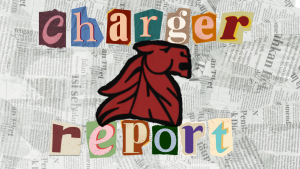Music in Video Games
April 6, 2020
Disclaimer: I’m not a musical expert. I’m a person who prefers music over people. Also, I have personally purchased all of these soundtracks. As such, please take this article with a grain of salt and a pair of headphones or earbuds.
With the recent need to isolate, people now lack social interaction as a medium for sanity. As such, many resort to music. Others resort to video games. Let’s combine the two.
Music in video games can be an unorthodox experience. Composers for individual games can go from a single person in audio software to entire symphonies. Most of the time, these experiences are fascinating and immerse players even further into the game. Fights with important enemies use unique music heard nowhere else, exploration is often upbeat or ambient, and story moments use atmosphere to their advantage. Perhaps some examples would help?
When it comes to all of the above, few games beat The Witcher 3: Wild Hunt. Focusing on the soundtrack, much of which originated from the game’s European roots, there is a huge amount to adore. Many will remember the combat pieces “Silver for Monsters…” and “…Steel for Humans”, and just as many will remember the quiet awe of “The Fields of Ard Skellig”. Even without the game itself, all of the music is great in its own right, and the history present within each and every piece of music in The Witcher 3: Wild Hunt is something to appreciate.
The other thing that often comes to mind in conjunction with music and video games is rhythm games. Many titles require inputs in time with the music, and some even change up the regular formula. One of those games is Crypt of the Necrodancer, a rhythm game that doubles as a dungeon crawler. Music changes per level, and so does the beat at which characters are allowed to do just about everything. It helps that the music choices themselves are quite catchy, especially in tracks like “Crypteque (1-2)” and “Mausoleum Mash (1-3)” – mostly because the difficulty of the game means that players will need to retry the same levels over and over again to finally beat the game – before realizing there are even more difficult options. What’s more, the game has multiple remixes for all of the music, meaning that the default option isn’t what players need to be stuck with for a majority of the game.
Thus far, I have refrained from speaking about more niche games and soundtracks, mostly because they aren’t going to be for everyone. So I’ll list several here without going into too much detail. First up is NieR: Automata, a game that changes the music’s input based on the action, from low-level ambience to symphonies and nonsensical lyrics. I’d especially recommend listening to “Amusement Park” if you’re interested. Next is the Phoenix Wright: Ace Attorney series, which is most well-known for its spiky-haired protagonist and the “Objection” theme. Then there’s the metroidvania title Hollow Knight, which specializes in ambient music that helps to develop atmosphere in such music as “Dirtmouth” and “Crystal Peak”. GRIS, the game with no words, has music like “Mae” that relies upon ambience and a sense of immersion. The Beat Hazard series has some stellar beats all it’s own, like “Beyond Imagination”, but players are also able to use their own music to play the game. Child of Light is one of not too many games to use classical inspirations in such tracks as “Aurora’s Theme” and “Magna’s Heart”. The violent cyberpunk title Katana Zero uses music like “Hit the Floor” to get the adrenaline going. Into the Breach likes to use tracks that get the strategic mind running with “Cataclysm” or “Into the Breach”. And if all of that isn’t enough to tide anybody’s musical tastes over, I’d also recommend listening to music from the titles (and series) of Bastion, Crawl, Danganronpa, Dead Cells, Don’t Starve, FTL: Faster Than Light, Kingdom, OneShot, Ori and the Blind Forest, Octopath Traveler, Persona, Starbound, Stardew Valley, and last but certainly not least, Subnautica. Don’t worry, because there’s one more game I’d like to talk about here. And that game is Minecraft.
Many may be wondering why Minecraft is being mentioned in an article all about music. After all, Minecraft doesn’t have much music, right? That, my hypothetical friend, is where you stand to be corrected. Currently, the composer for Minecraft, C418, has released two albums: Volume Alpha and Volume Beta, with an unknown third album having been announced some time ago. The two albums released at present have a combined total of some three hours, twenty minutes worth of music. That’s actually par for the course as far as most video game soundtracks go. But I still haven’t talked about the gorgeousness that is the music, have I? Whether it be the extremely nostalgic “Haggstrom”, “Minecraft” itself, “Mice On Venus”, “Dry Hands”, “Wet Hands”, “Sweden”, or even “Subwoofer Lullaby”, the extreme calm and peace that exudes from the Minecraft soundtrack would be worthy of the game’s already immense prestige on its own. And all of those tracks that I just mentioned come from Volume Alpha. Volume Beta has tracks that go on for even longer, and most of them tend to have more of an explorative or active tone. If I could mention some of them, I’d be sure to recommend “Alpha”, “Dead Voxel”, “Moog City 2”, “Biome Fest”, “Mutation”, “Haunt Muskie”, “Aria Math”, “Beginning 2”, and the ironic last title in the album “Intro”. Now that I say write them out, Minecraft really does have some bizarre names for its music. But anyways.
Whether the music comes from a single person or a whole orchestra of people, video games have some utterly amazing music that can be incredibly hard to experience elsewhere. Whether the player is exploring the world with a calm tune or listening to the latin lyrics of a boss fight, there’s something for everybody. Even then, I’ve probably failed to persuade some people to give these beautiful soundtracks a listen, I’m sure. So sometime, when all of this quarantine stuff is over, go ahead and find something that fits what you like. Even if everything I’ve mentioned here isn’t to your liking, I haven’t listed entire genres, both of songs and video games, with unique notes and themes to listen in on. Sometimes, beauty can be found in the eye of the beholder. Other times, I like to think that beauty is found in the ears of the listener.







